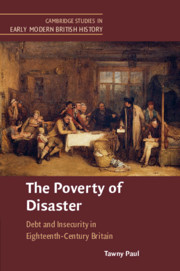Book contents
- The Poverty of Disaster
- Cambridge Studies in Early Modern British History
- The Poverty of Disaster
- Copyright page
- Dedication
- Contents
- Figures
- Tables
- Acknowledgements
- Introduction
- Part I Structures of Insecurity
- Chapter 1 The Scale of Incarceration
- Chapter 2 Credit and the Economic Structures of Insecurity
- Chapter 3 Social Structures of Insecurity
- Part II The Insecure Self
- Part III The Debtor’s Body
- Bibliography
- Index
Chapter 3 - Social Structures of Insecurity
from Part I - Structures of Insecurity
Published online by Cambridge University Press: 27 September 2019
- The Poverty of Disaster
- Cambridge Studies in Early Modern British History
- The Poverty of Disaster
- Copyright page
- Dedication
- Contents
- Figures
- Tables
- Acknowledgements
- Introduction
- Part I Structures of Insecurity
- Chapter 1 The Scale of Incarceration
- Chapter 2 Credit and the Economic Structures of Insecurity
- Chapter 3 Social Structures of Insecurity
- Part II The Insecure Self
- Part III The Debtor’s Body
- Bibliography
- Index
Summary
Financial structures were not the only reason for middling insecurity. Imprisonment was also social and circumstantial. It was the result of decisions made by creditors, based upon perceptions of a debtor’s credibility and reputation. Chapter 3 turns to the perspectives of creditors. The positions and reasoning of those who used the prison as a tool are crucial to understanding insecurity. The chapter considers why creditors chose to send their debtors to prison and how it was in their interests to do so. Imprisonment depended upon how economic failure was perceived, as well as upon creditors’ entangled financial, social and emotional positions. While imprisonment could provide a useful tool for enforcing contracts within an economy that offered little protection to those who lent money, the importance of emotion and social perceptions of failure tempers the weight that we afford to ‘rational’ decision-making within the modernising economy. Like credit, debt was understood as part of a moral economy.
- Type
- Chapter
- Information
- The Poverty of DisasterDebt and Insecurity in Eighteenth-Century Britain, pp. 95 - 134Publisher: Cambridge University PressPrint publication year: 2019



